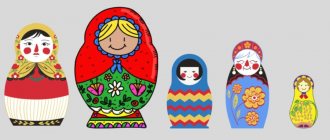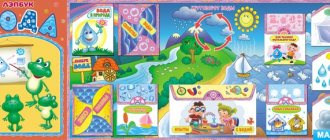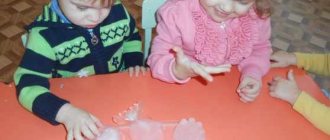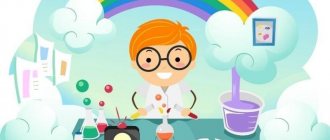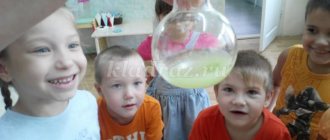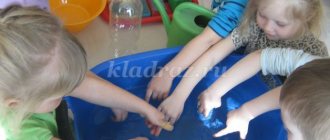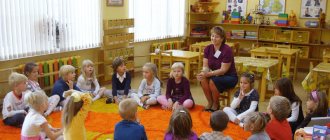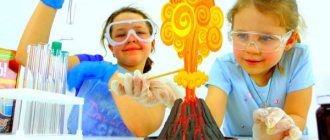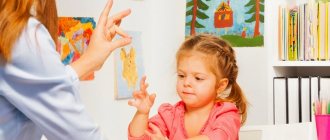CARD FILE OF EXPERIMENTS - EXPERIMENTS WITH WATER FOR YOUNGER GROUPcard file (junior group) on the topic
“Let’s find out what kind of water it is?”
1.Water clarity
Goal: formation of initial ideas about the properties of water; ability to experiment with substances (water) Materials: 3 glasses (1 with clear liquid, 2 tinted with gouache, 3 with milk); medium-sized stones, aprons. Procedure: At the teacher’s suggestion, one child drops a stone into a glass of clear water; the other into a colored liquid; the third into milk. They are considering. Answer questions. Together with the teacher they compare. Leading children to understand the properties of water - transparent
“Let’s find out what kind of water it is?”
2. The smell of water
Goal: formation of initial ideas about the properties of water; ability to experiment with substances (water) Materials: 2 glasses of water, lemon, aprons. Procedure of the experiment: At the teacher’s suggestion, children sniff the water in the first glass, then for comparison we suggest sniffing the water in the second glass, where previously (or at the moment) was squeezed lemon juice is added. Together with the teacher, the children compare smells. Answer questions. Lead children to understand the properties of water - odorless.
“Let’s find out what kind of water it is?”
3. Taste of water
Goal: formation of initial ideas about the properties of water; ability to experiment with substances (water); compare. Materials: water, 3 glasses, salt, sugar, spoon, aprons. Procedure of the experiment: At the teacher’s suggestion, children try plain boiled water in the first glass, then for comparison, salt is added to the second glass of liquid, respectively, sugar is added to the third glass (according to possibility of involving children in performing these actions), mix thoroughly with a spoon. Children try, compare, answer questions. Leading children to understand the properties of water - odorless
“Let’s find out what kind of water it is?”
4. Water transfusion
Goal: formation of initial ideas about the properties of water; the ability to experiment with substances (water), practicing pouring water from a bottle into a glass and back into the bottle using a funnel. Materials: transparent white plastic bottles (capacity 0.33 l) (4 pcs.), half filled with water; 8 high narrow lenses plastic. glasses, a transparent bowl and a wide cup (4 pcs.); funnel (4 pcs.); tray; oilcloth, aprons according to the number of children. Procedure of the experiment: At the teacher’s suggestion, children pour water alternately into different containers: glasses, bowls, wide cups. The teacher reminds them to be careful during the pouring process. Leads children to understand that water flows, pours from one vessel to another, taking its shape. Questions for children: What did you do? What did you pour the water into? Is water flowing?
"Colorful Water"
(Water coloring)
Goal: formation of initial ideas about the properties of water; ability to experiment with substances (water). Materials: Transparent white plastic bottles (capacity 0.33 l) (4 pcs.) half filled with water, caps for each bottle (a little gouache of 4 primary colors is applied to the bottom of each bottle); tray; napkin, aprons according to the number of children. Procedure of the experiment: Together with the teacher, the children examine the liquid in each bottle, then the teacher, taking one of the bottles, screws the cap on it, and, attracting the attention of the children, shakes it. The water is painted in the color of the paint applied on the lid. At the teacher's suggestion, children get involved in coloring the water by shaking their bottles. They answer the question: what color is the water colored? Leading children to understand that water turns any color if you add paint to it.
“Water is our helper”
“Water is our helper”
1.Game situation “Dirty girl”
Goal: development of curiosity and cognitive motivation in children; formation of initial ideas about the properties of water. Materials: doll, jug of water, napkin, basin. Creation of a problem situation: bringing in the doll with dirty hands. Acting out the situation (observation of children washing the hands of a doll from a jug of water over a basin, wiping). Leading questions to children, listening to children's answers, encouragement, prompting the right words, then jointly summarizing what was said. Leading children to understand the properties of water: water washes away dirt.
2. “We can’t go anywhere without water”
Goal: formation of cognitive actions during experimentation with substances (water); the ability to establish cause-and-effect relationships and draw conclusions. Materials: table-pallet for experimenting with sand and water; sand sets for each child, a jug of water, napkins, aprons. Progress of the experiment: At the teacher’s suggestion, children make crafts in molds from wet sand, helping themselves with their hands (“Let’s bake pies”); The teacher draws the children's attention to their hands. Questions for children: What needs to be done to make your hands clean? Maybe shake them off or blow on them? Are your hands cleaner? How to clean sand from your hands? Listening to answers. Washing hands from a jug, wiping with napkins. Summarizing what has been done, leading to an understanding of the properties of water: washes away dirt, making objects cleaner.
3.Water can pour, or it can splash.”
Goal: formation of initial ideas about the properties of water; the ability to experiment with substances (water). Materials: watering can, indoor plants, spray bottle. Organization of children’s observation of watering indoor plants. Questions for children: What happens to the water when I tilt the watering can? Where does it flow from? Listening for answers. Acquaintance with a special device for spraying - a spray gun. Explanation that it is needed to spray on flowers in hot weather. We spray and refresh the leaves, they breathe easier. Flowers take a shower. Offer to observe the spraying process. Draw the attention of children that the droplets are very similar to dust, because they are very small. An offer to put your palms up and spray them. Questions: What are your palms like? (Wet.) Why? (Water was splashed on them.) Bringing children to understand that water can pour or splash.
“Let’s collect some water”
Goal: formation of initial ideas about the properties of water and other materials; cognitive actions during experimentation with substances (water) Materials: basin, glass of water, wide cup, multi-colored foam sponges, aprons according to the number of children, napkins, oilcloth. Expert procedure: Each child is given a sponge, activating in speech the name of the color of the sponge ; the teacher demonstrates the actions of collecting water poured onto the table (a small amount) covered with oilcloth from a glass; squeezing it from a sponge into a wide cup; involving children in performing actions according to the model. Leading to an understanding of the properties of water - it takes the form of an object, a vessel; properties of materials - foam sponge - absorbs liquid, helping to collect water.
"Ships"
The property of objects is buoyancy
Goal: development of curiosity and cognitive motivation in children; formation of initial ideas about the properties of water and other materials; cognitive actions during experimentation with substances (water) Materials: a bowl of water, paper boats, boats made of walnut shells and boxes, aprons according to the number of children. Procedure of the experiment: At the suggestion of the teacher, the children lower (one by one) paper boats into the water, boats made of shells and boxes, watching them. Questions for each child, commenting on the results. Play out the situation by inviting the children to make “wind” and “waves” (imitation of a breeze). Observing the movement of objects through water. Leading children to understand the properties of floating objects.
"Sinks and floats"
Goal: developing the ability to experiment with materials and substances (water); children's exercise in catching objects from the water using nets. Materials: basin with water; nets; small objects made of different materials (wooden and metal spoons, plastic and wooden balls, small rubber balls); rubber toys (one has the bottom cut out to compare which toys sink and why); paper boat; small pebbles; tray; napkins; aprons.-Puzzling riddles about water (see card index of artistic works about water). Encouraging children to experiment with water and other materials. At the teacher’s suggestion, children pick up objects, name them, and carefully lower them into the water. Questions for each child, the teacher comments on the result (What did you take? What color is the ball? Did the ball sink or float? - This is a wooden ball, it does not sink, it floats on the surface of the water. Similar lowering of other objects into the water, observation. At the end of the experiment, a proposal to the children catch objects from the water using a net.-Activation with the help of the output teacher: which object floats and which one sinks.
"Steam is also water"
Goal: development of curiosity and cognitive motivation in children; formation of initial ideas about the properties of water. Materials: thermos with boiling water; mirror. - Attracting children's attention to observing the steam rising from an open thermos, becoming familiar with the properties of water - steam. Reminder of safety rules when working with boiling water. Activation of children's cognitive interest: placing a mirror over the steam and showing the droplets of water that appear on it.
"Let's freeze the water"
1. “Introduction to the properties of ice”
Goal: developing the ability to experiment with materials and substances (water); exercise in pouring water with a spoon. Materials: spoons, bowls with water colored in 4 primary colors, molds for playing with sand, tray, napkins, aprons, oilcloth. - Demonstration and explanation by the teacher of the method of doing the work - pouring a spoon of colored water from a bowl into a mold for playing in the sand. Invite the children to complete the task on their own at the end, the molds are transferred and placed on a tray. The tray is then placed in the freezer. The next day, before the walk, a tray with molds is brought into the group, and children are organized to observe what happened to the water (the water froze and turned into ice, because it is very cold in the refrigerator). Then the teacher and the children take ice out of the molds, take it outside and decorate the snow on the site with it during a walk. - Leading children to understand the properties of water - water can freeze into ice, ice is solid water.
"Ice"
Goal: developing the ability to experiment with ice; name the properties of ice: slippery, wet, cold. Materials: molds with ice (unpainted and painted), a basin of water, nets, a tray, aprons, oilcloth. - At the suggestion of the teacher, the children take the ice in their hands, examine it, and share their impressions. Questions from the teacher individually for each child: Are the pieces of ice slippery? Do the pieces of ice want to slip out of your hands? What kind of ice: warm or cold? Then the children, together with the teacher, put the ice in a bowl of water (a reminder to be careful when lowering the ice into the water so as not to get their hands wet). Drawing children's attention to their hands: wet. Why? Have you ever dipped your hands in water? Why are your hands wet? - Leading children to understand that ice melts from heat, but their hands are warm (suggestion to wipe their hands with napkins) - Organizing children’s observation of ice in water: floats, does not sink. - Leading children to understand that ice is lighter water. The teacher's proposal to catch pieces of ice on a tray with a net, helping children in catching. Using questions, intensify the speech activity of children, clarify whether there are many pieces of ice on the tray. During the day, attracting the attention of children to the process occurring with the pieces of ice left by the teacher in the bath (without water), noting changes (ice melts, water appears; all pieces of ice have melted, there is water in the bath). - Bringing children to understand that water turns into ice when it is very cold, into water when it is very warm.
"Snow"
Goal: developing the ability to experiment with snow; ideas about winter natural phenomena; development of tactile sensations; temperature differences (cold snow) Materials: a bath with snow, a toy dog. - A bath filled with snow is brought into the group. Encouraging children to experiment with snow: looking at it, asking them to pick it up, asking: What is this? What colour is he? What type of snow is it: cold or warm? Why did your hands become wet? Leading children to understand that the snow melts from the heat, and their hands are warm. - Organization of a game situation: a toy is brought in - a dog, with the help of which footprints appear in the snow in the bath (the teacher moves the toy through the snow, pressing it in the snow so that the tracks are clearly visible). A reminder to children about observing the tracks left (animals, humans) while walking; clarification about the size of the footprints: the footprints can be large from large feet and small from small ones. Activation of children's play actions under the sound of a word (finger game: “Big feet walked along the road”) - At the end of experimenting with snow, drawing the children’s attention to the fact that the snow in the bathtub has almost melted, there is less of it, but water has appeared - dirty water. -Leading children to understand basic concepts of snow.
Lesson summary with elements of experimentation for junior group 2 “Magic water”
Topic: “Magic water”
Target:
Introduce children to the properties of water (transparent - opaque, colored - colorless, liquid).
Tasks:
- give children initial experimentation skills;
- consolidate knowledge of colors: red, yellow, blue, green;
- activate the words “transparent”, “opaque”, “colored”, “colorless”, “liquid” in children’s speech;
- consolidate the count to 4.
Equipment:
a chest with a bottle of water, jars of paint (yellow, red, blue, green) according to the number of children, brushes according to the number of children, transparent jars of water, Kinder surprise toys, a tray, a rag, paper napkins, paper boats.
Progress of educational activities:
Org. Part:
Guys, today we have guests, they want to see how we are doing. Let's say hello to them!
Let's gather together in a circle,
You are my friend and I am your friend.
Let's hold hands together
And let's smile at each other.
There is a knock on the door. - Guys, you hear someone knocking on the door. Oh, what a beautiful chest they gave us. I'm so curious what's in it. Are you guys interested? The chest says: “Guess the riddle and find out what’s inside.” Listen carefully to the riddle:
We can't wash ourselves without it,
Don't eat, don't get drunk.
They drink it, they pour it out.
Everyone needs her.
What is this? ( water
)
Right!
Guys, tell me, why do we need water, what do we do with it? (we drink, wash, we need water to cook food, water the flowers).
Game "Hide the toy"
Guys, do you know that water is a magician? She invites you to her kingdom - the Kingdom of Water and invites you to play with her. ( There are 6 jars of water (clean and cloudy) on the table.
Look, there are jars of water on the tables. Take a toy each and hide them in our jars.
Look, guys, who has a toy? At Varya, Bogdan, Artyom. But Seiran and Vanya are not visible. Why did this happen?
Right. The water could not hide the object, because clean water is transparent. “ transparent” together
.
Now tell me, Bogdan, Varya, Nastya. Guys, in what water is the toy hidden, where it is not visible? ( in opaque ).
Let's say “opaque” together.
— In this jar the water is clear and you can see the toy. And in the other it is opaque, so the toy is not visible.
- Do you think the water has a color? Nastya? Artyom?
- In fact, water has no color, it is colorless
.
“colorless”
together .
You know, guys, sometimes water gets upset because it has no color. How can we help her? Let's color the water. Everyone come to the tables.
Game "Colored Water".
You have jars of paint and brushes on your tables. Choose your own paint and add colored gouache to your glass of clear water. Look, now the magic begins - water quickly dissolves the paint.
— What color is the water in your glass, Artyom? (red)
— What color of gouache did you add to the water? And it turned out... ( green water)
— What color of gouache did you Bogdan add to this glass? (yellow)
— What color did you get the water, Varya? (blue)
- Guys, look, we have colored water. What kind of water did we get? “colored” together
. Repeat Vanya, Seiran.
The teacher puts out 4 jars of colored water. Guys, look how many jars of clean, clear water we have? (one), and with a colored one? (four). Children name colors. Well done!
Now let's dance, now you will turn into droplets of water.
Physical education
Game "Pour the water"
Everyone come to the table. What else can water do? Look. Guys, what does water do? (flows, overflows). Let's listen to how it flows?
- Why does it flow and shimmer? Yes, because it is liquid. "liquid" together
.
- Now put the jars on the tray and see how many colorful puddles there are on our table. But they can be easily wiped off, because the water is liquid and absorbs well. Look, we have napkins and a cloth. Let's wipe all the spilled water off the table. Well done!
Summarizing.
- What did we learn about water today, what can it be? (transparent or opaque, colorless or colored, and water can also be poured and easily wiped off, because it is liquid).
Surprise moment.
Well done guys, you did a good job today. In memory of our meeting, water gave you small gifts - boats. You can launch them across the water.
2
Abstract of the GCD in the second junior group “Water, water, water all around.”
Municipal budgetary preschool educational institution "Yusvinsky kindergarten "Golden Cockerel"
FULL NAME. teacher:
Uteva Larisa Valerievna
Nomination:
Educational activities with preschoolers
Age group:
second youngest
Theme:
“Water, water, water all around.”
Main educational area:
Getting to know your surroundings
Integration with other areas:
Gaming, communicative, educational and research.
Target:
development of cognitive and research activities, creation of a favorable atmosphere in the process of joint activities.
Educational work:
cultivate dedication and independence in completing tasks. To instill in children a sense of mutual assistance and joy. cultivate accuracy in work; cultivate a careful attitude towards water.
Developmental tasks:
develop observation, develop speech activity, auditory perception, speech, thinking, activate vocabulary on the topic.
Educational and formative tasks:
give children an idea of why we need water, that water has no odor, continue to form children's ideas that water can change color. To develop experimentation skills in children; develop the ability to make simple conclusions.
Planned result:
introduce the properties of water.
Methods and techniques:
demonstration, conversation, experiment.
Materials and equipment
: 3 basins of water, jars of water for each child, brushes, watercolor paints, indoor flower, stones.
Preliminary work:
talking with children about the meaning and properties of water, looking at illustrations, observing on walks, reading and memorizing poems, riddles, and conducting individual experiments with water.
Used
: gaming, experimental types of children's activities.
Progress of the lesson:
V.: Today I will tell you guys and show you a lot of interesting things about water.
Have you heard about water? They say she is everywhere!
In a puddle, in the sea, in the ocean and in a water tap.
Without water we can’t wash ourselves, we can’t eat, we can’t get drunk!
I dare to tell you that we cannot live without water!
V.: Look, guys, there are flowers on the table. Try smelling them. Do the flowers smell? ( Yes)
V.: Let's smell the water. Does the water smell?
D.: No, it is odorless.
Q: Look, what kind of water is in my jar?
D.: transparent, colorless, clean.
Q: What other kind of water is there? (children's answers: cold, hot, warm).
V.: That's right, guys. Water can be different.
V.: Look how you can play with water. (There are 3 basins of water on the table, children are divided into subgroups.)
Q: When we put our hands in the water, what do they become? (children's answers: wet) Look, droplets have appeared on my fingers. What are they? (small, transparent). How do I drop droplets? Drip, drip, drip, like a fine, fine rain. Let's make it rain together.
Physical school Drop one, Drop two, (Jumping on tiptoes, hands on belt). Very slowly at first. And then, then, then, Everybody run, run, run. We opened our umbrellas (Spread our arms to the sides). Sheltered herself from the rain. (Close your hands above your head in a semicircle).
V.: Now we will sit at the table and conduct an experiment with water. (The teacher pours water from a bottle into a jar for everyone.)
V.: Each of you has a pebble on your table. Take a pebble and put it in a jar. See if you can see the pebble through the water? (Children complete the task and say what they see.)
Q: Why do you see a pebble?
(Children answer together. The teacher asks the same question to each child and receives individual answers.)
V.: Great. If the water is clear and clean, then everything can be clearly seen through it.
V.: Shall we play again? You need to add a little paint to the water. Guys, let's try? (Yes.)
IN.:. What color is the water?
(Children complete the task, say what they see. The water turns different colors. Children are surprised at what is happening, the children’s answers are blue, yellow, red.)
Q: Is the pebble visible now? (Children: answers to questions.)
V.: Correct. Your pebbles have become almost invisible due to the fact that the water in the bottles has become colored.
Q: Can I drink this water? (No)
V.: You can’t drink this kind of water correctly, you can’t wash your hands with this water, you can’t water flowers with it.
V.: In kindergarten you and I drink only clean water. Do you drink clean water at home? Children's answers.
IN.:
That's right, you can only drink clean water. Drinking dirty water is harmful and even dangerous. You may feel bad, you may get sick.
Q: Why do we need water?
D.: Wash, wash, cook, water plants, swim in the river, wash floors, drink, etc.
Q: Where do we meet water?
D.: There is water in the river, water flows from the tap, rain, snowflakes, snow, icicles, ice, etc.
V.: Well done, what you say is true.
Q: Guys, what do you think will happen without water?
D.: Everything around will be dirty, we won’t be able to drink, plants, fish, animals will die, people won’t be able to live, etc.
V.: That's right guys. Without water, people, animals, and flowers cannot survive.
V.: Great! How much do you know about water? Well, since every living thing on earth needs it so much, it simply needs water. Yes, not just water, but clean, transparent. What do you think should be done to save water?
D.: Turn off the tap on time, do not waste too much, do not throw garbage into the river yourself, forbid others.
Don't waste water,
Know how to value water,
Close the tap tight
So that the ocean does not leak out!
Conclusion:
Guys, what did we talk about today? That's right, about water!
What did you learn about water today?
V.: Correct. Well done. We learned that water has no odor. She can change color. People, animals and plants need water.
And don't forget to save water! Water is the source of life!
